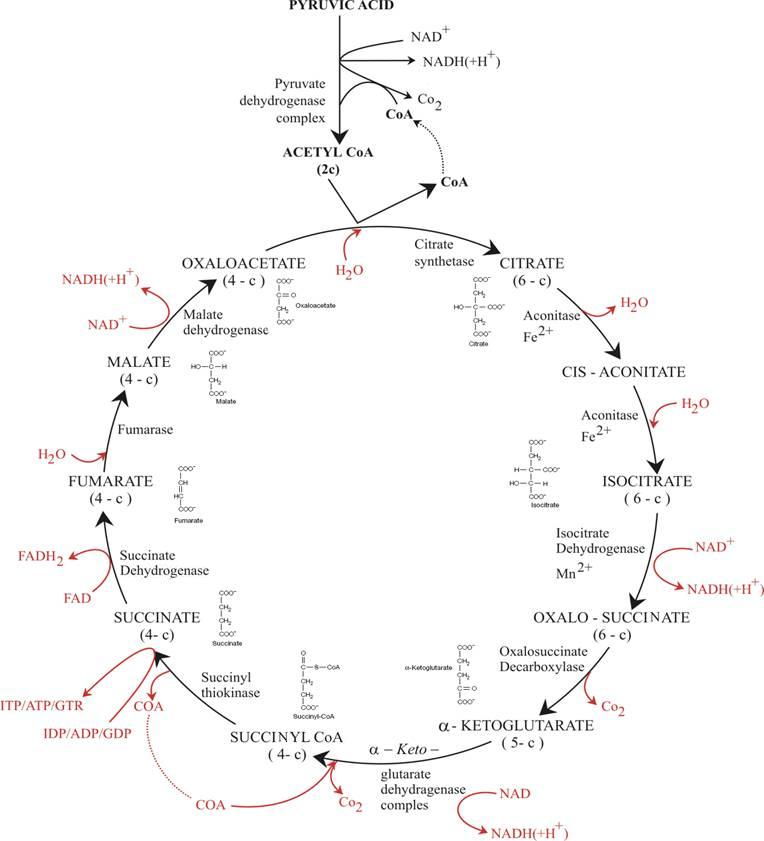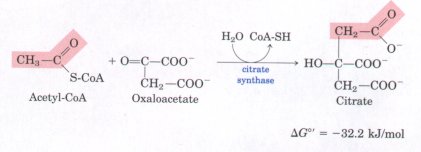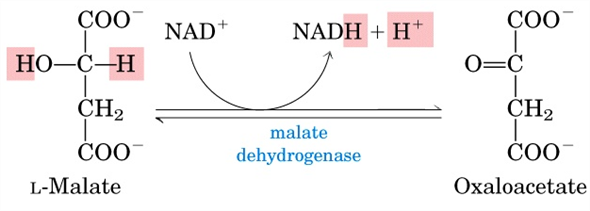
Citric acid cycle or Krebs cycle or Tri-carboxylic acid (TCA) cycle
- Citric acid cycle is a central metabolic pathway for metabolism of carbohydrates, fats and proteins. Citric acid cycle occurs in aerobic condition in mitochondria.
- At first carbohydrates, fats and proteins are catabolized by separate pathway to form acetyl-coA then Acetyl-coA enters into Citric acid cycle.
- It is also known as Krebs cycle or Tri carboxylic acid (TCA) cycle.

Figure: Citric acid cycle
Two major reactions involved in citric acid cycle.
- Formation of acetyl-coA
- Reactions of citric acid cycle
1. Formation of acetyl-coA:
- Before entering into Krebs cycle, carbohydrates, fats and proteins are catabolized by separate pathway to form Acetyl-coA.
- For example: pyruvate formed by aerobic glycolysis is oxidized into acetyl-coA and CO2 by the enzyme Pyruvate dehydrogenase complex.

- It is an irreversible oxidative decarboxylation reaction in which a molecule of carbon in the form of CO2 is removed from pyruvate.
- In this reaction a molecule of pyruvate generate 1 NADH.
- This step is link between glycolysis and Krebs cycle.
2. Reactions of citric acid cycle
i. Formation of citrate (citric acid):

- It is a condensation reaction. Acetyl-coA condensed with oxaloacetate to form citrate and the reaction is catalyzed by the enzyme Citrate synthase.
- Oxaloacetate play catalytic role in citric acid cycle and at the end of process oxaloacetate is regenerated.
ii. Isomerization of citrate to Isocitrate:

- The enzyme aconitase catalyzes the isomerization of citrate to isocitrate with intermediate cis-aconitate.
- This is a reversible reaction.
- This reaction occurs in two steps- first dehydration and second hydration.
iii. Formation of α-ketoglutarate:

- This is an oxidative decarboxylation reaction.
- The enzyme isocitrate dehydrogenase catalyzes the oxidation of isocitrate to form α-ketoglutarate and CO2.
- In this step 1 molecule of NADH is generated.
- It is an irreversible reaction.
iv. Formation of succinyl-coA:

- This is also an oxidative decarboxylation reaction catalyzed by α-ketoglutarate dehydrogenase enzyme in which α-ketoglutarate is oxidized into succinylcoA and CO2.
- In this reaction, coA serves as carriers of succinyl group and NAD+ serves as electron acceptor.
- One molecule of NADH is generated in this step.
v. Formation of Succinate:

- Conversion of succinyl-coA to succinate is catalyzed by succinyl-coA synthetase or succinic thiokinase enzyme.
- This is a substrate level phosphorylation reaction in which CoA group ultimately donates its phosphate group to GDP forming energy rich GTP.
- A molecule of CO2 is released in this step.
vi. Formation of fumarate:

- Succinate dehydrogenase catalyzed the oxidation of succinate to from fumarate.
- It is reversible reaction.
- In this step a molecule of FADH2 is generated.
vii. Formation of malate:

- This reaction is catalyzed by fumarase (fumarate hydratase) in which fumarate is converted into malate.
- This is a hydration and reversible reaction.
viii. Formation of oxaloacetate: regeneration of oxaloacetate:

- Malate is oxidized into oxaloacetate generating a molecule of NADH.
- This reaction is catalyzed by malate dehydrogenase enzyme.
- Oxaloacetate is regenerated in this step and combines with acetylcoA and continues the cycle.
Significance of TCA cycle: Role of TCA cycle
i. Role in Central metabolic pathway:
- TCA cycle is a final common metabolic pathway of carbohydrates, fattyacids and aminoacids.
- At first all these biomolecules are catabolized by their separate metabolic pathways to generate acetyl-coA then acetyl-coA enters TCA cycle for further metabolism in aerobic condition.
- TCA is more efficient in energy conservation than other pathways of metabolism.
ii. TCA is an amphibolic pathway:
- It plays role in both catabolism and anabolism.
Catabolic role:
- TCA is a catabolic pathway because it oxidizes acetyl-coA completely into CO2 and H2O and releases large amount of energy.
Anabolic role:
- TCA is an anabolic pathway because it provides precursors for biosynthesis of other molecules in cells. Such as citrate, α-ketoglutarate, succinylcoA and oxaloacetate act as precursors for biosynthesis of various molecules.
- Glucose, purine and pyrimidine are synthesized from oxaloacetate.
- Fattyacids and steroids are synthesized from succinylcoA.
- Some aminoacids, purine and pyrimidine are synthesized from α-ketoglutarate.
iii. Citric acid cycle is an aerobic process:
- NAD+ and FAD are electron acceptors in the TCA cycle. These are regenerated by Electron transport chain which requires oxygen as final electron acceptor. Hence overall TCA and ETC are aerobic process.
Citric acid cycle or Krebs cycle or Tricarboxylic acid (TCA) cycle
